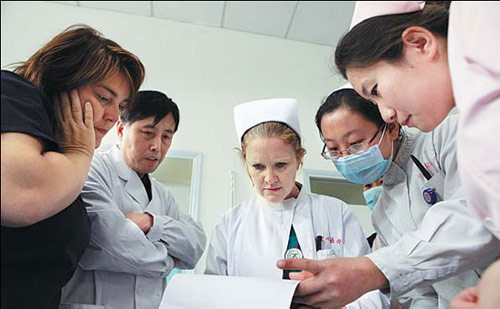Awards for top innovation
Updated: 2012-11-26 10:12
By Wang Zhuoqiong and Liu Jie (China Daily)
|
|||||||||||
 |
|
Chinese and Canadian doctors exchanging views about treatment of heart disease patients at a hospital in Taiyuan, the capital city of North China's Shanxi province. The 13th Wu Jieping-Paul Janssen Medical & Pharmaceutical Award was given to 11 top Chinese pharmaceutical, medical and healthcare professionals for their contributions to improving the quality of patient healthcare through innovation. Liu Jiang / For China Daily |
Chinese pharmaceutical, medical and healthcare professionals lauded
Eleven top Chinese pharmaceutical, medical and healthcare professionals were honored in Beijing last month with the 13th Wu Jieping-Paul Janssen Medical & Pharmaceutical Award for their leadership and innovation.
The award supports exemplary efforts by practitioners who work to improve the quality of patient healthcare through innovation and is consistent with China's ambition of establishing a national innovation system by 2020 in which talent development is a critical aspect of the overall plan.
Set up in 1994, the Wu-Jan Award promotes innovative medical, pharmaceutical and healthcare professionals in China and was co-established by the International Exchange and Cooperation Center of the Ministry of Health and Xian Janssen Pharmaceutical Ltd, a Johnson & Johnson pharmaceutical company.
As of this year, 327 Chinese scholars have been honored with the award. Today, the Wu-Jan Award is one of China's most established, multi-category professional awards.
"The Wu-Jan Award honors professionals whose innovative work improves the health and quality of life of the Chinese people. Xian Janssen is delighted to support this award. We are committed to caring for patients and constantly striving to improve China's public health," said Thad Huston, president of Xian Janssen.
"External innovation has been created through collaborations with top academic institutions with top scientists from the United States and China," Huston added. "The more we understand the needs of patients, the better we can focus our efforts on helping them."
For example, in addition to its own expansion in research and development in Shanghai and Beijing, Xian Janssen has also worked with Tsinghua University's School of Medicine for the prevention and treatment of infectious disease.
The company also supports talent programs for the university. The best way to cultivate innovation at top academic institutions in China is to cultivate talent, said Professor Shi Yigong, who is also the dean of the School of Life Sciences at Tsinghua University.
Xian Janssen has invested $4 million over five years in the school to recruit top talent from home and abroad.
"If you don't have the best people, how can you get the best results from research projects?" Shi asked. "Xian Janssen's breakthrough way to support us in attracting the best talent is a great contribution to our education and research programs."
Like Xian Janssen, a series of multinational companies are actively investing in cooperation with Chinese universities and medical institutions to conduct R&D work, especially on early-stage research, given the specialties of the local partners' research teams and laboratory facilities.
Bayer HealthCare Co has been cooperating with Tsinghua University over innovative drug discovery since 2009. The joint projects focus on different research aspects starting from early research programs to gain deeper understanding of disease mechanisms, identification of new drug targets and spanning further to joint structural biology research and medicinal chemistry programs.
"A new focus of our collaboration will be the area of structural biology, where scientists from Tsinghua University will work in close collaboration with Bayer scientists to solve the 3D protein structure of biological molecular targets as a basis for new drug discovery projects," said Shi, when the two sides decided to extend the partnership to 2014.
At the end of 2011, Merck Sharp & Dohme Corp - known in the United States and Canada as Merck & Co - revealed its plan to invest $1.5 billion in R&D in China over five years. In addition to building its Asia R&D headquarters in Beijing, some of the money is earmarked for collaboration with local universities and medical institutions, according to Peter Kim, president of Merck Research Laboratories.
"The decision to locate the facility in the capital city was made to bring the company closer to national-level and first-class research bodies and universities - such as Peking University, Tsinghua University and Beijing Institute of Life Science (a division of the Chinese Academy of Sciences)," Kim said, adding that the company also hopes to attract high-quality young talent to the universities via the partnership.
Contact the writers at wangzhuoqiong@chinadaily.com.cn and liujie@chinadaily.com.cn
Related Stories
Lindsay Lohan had asthma attack 2012-09-26 09:40
Qinghai benefits from medical system reform 2012-07-30 09:23
A unique calling 2012-07-13 13:31
Tourists find cure for what ails them 2012-05-11 13:08
Shortage of life-saving heart drug 2011-09-13 11:11
Today's Top News
Rescuers race against time for quake victims
Telecom workers restore links
Coal mine blast kills 18 in Jilin
Intl scholarship puts China on the map
More bird flu patients discharged
Gold loses sheen, but still a safe bet
US 'turns blind eye to human rights'
Telecom workers restore links
Hot Topics
Lunar probe , China growth forecasts, Emission rules get tougher, China seen through 'colored lens', International board,
Editor's Picks

|

|

|

|

|

|





